|
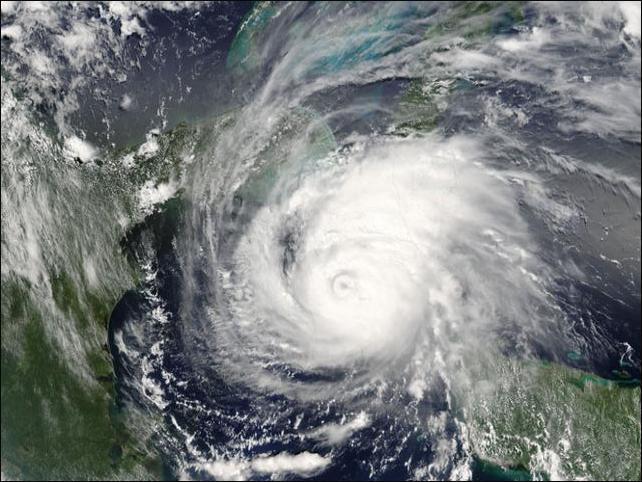
Hurricane Katrina
By
Susan McGuire
On August 28, 2005,
Hurricane Katrina was in the Gulf of Mexico where it
powered up to a Category 5 storm on the
Saffir-Simpson hurricane scale packing winds
estimated at 175 mph.
At
7:10 a.m. EDT on August 29, Hurricane Katrina made
landfall in southern Plaquemines Parish, Louisiana,
just south of Buras, as a Category 3 hurricane.
Maximum winds were estimated near 125 mph to the
east of the center.
Hurricane Katrina was the sixth strongest hurricane
ever recorded and the third strongest hurricane to
make landfall in the U.S. In New Orleans, the
evacuation plan was particularly crucial because it
is in the Storm Surge Zone, below sea level (up to
six feet in some places). Its levies were only
designed for a Category 3 and Katrina was forecast
as a Category 4 featuring gusts topping 140 miles an
hour (225 kilometers an hour). The storm surge from
Katrina was 20 feet high. The failure of the levees
was due to system design flaws combined with the
lack of adequate maintenance. All those in charge
did not devote attention to the levies in the
region.
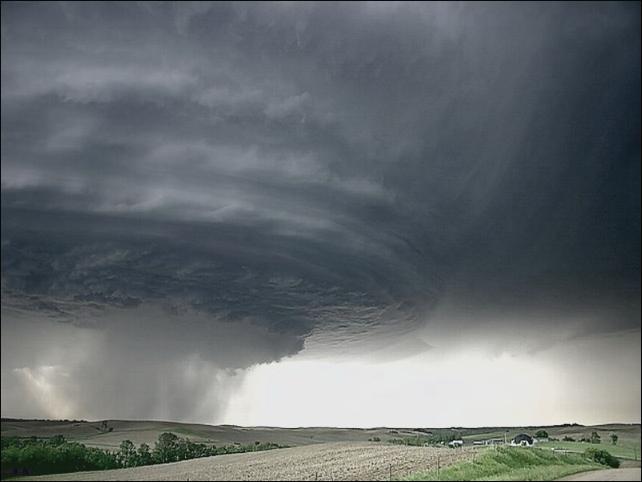
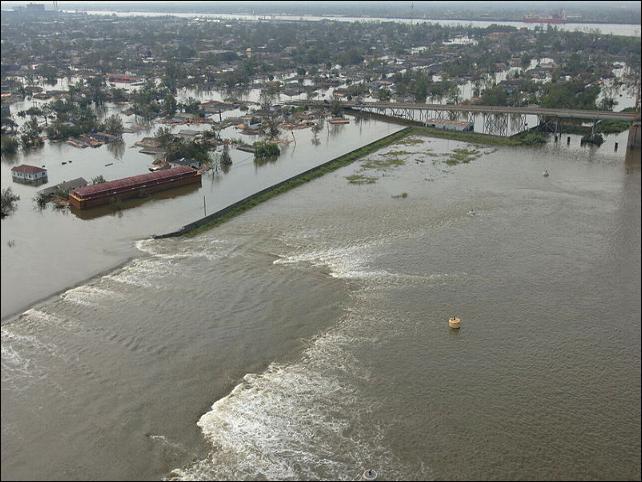
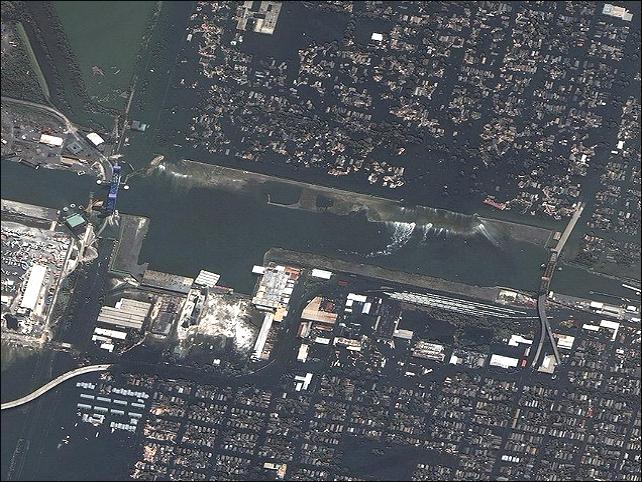
The 800 foot levee break on New
Orleans' Surkote Road
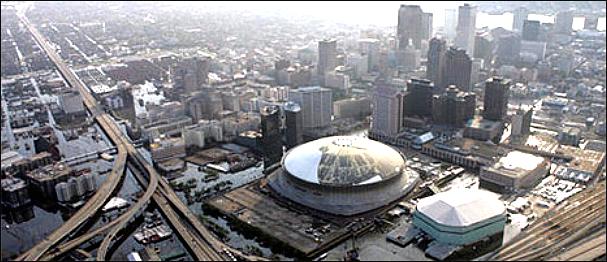
The Superdome and a man who
couldn't endure waiting for help.
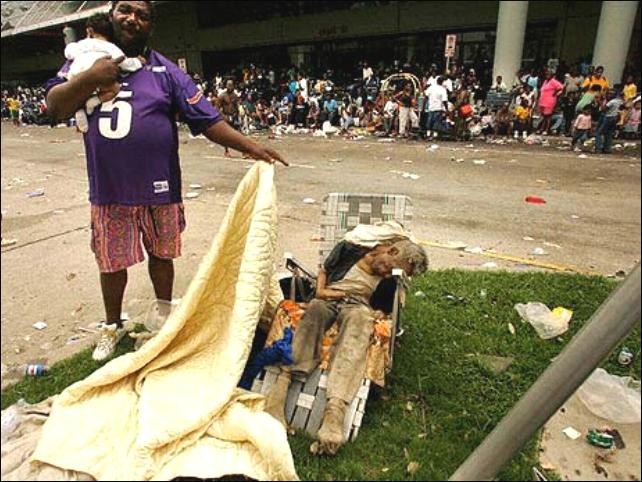
More than one million Gulf Coast residents were
displaced, and many of the refugees were living
below the poverty line before the storm struck. The
final death toll was a 1,836, primarily from
Louisiana (1,577) and Mississippi (238). An
estimated 80 percent of New Orleans was under water
up to 20 feet deep in places. Hurricane Katrina
caused $75 billion in estimated physical damages,
the most costly hurricane in history. It is
estimated that the total economic impact in
Louisiana and Mississippi may exceed $150 billion.
About 90,000 square miles were affected. Before the
hurricane, the region supported approximately one
million non-farm jobs, with 600,000 of them in New
Orleans, but hundreds of thousands of local
residents were left unemployed. More than 70
countries pledged monetary donations or other
assistance. Kuwait made the largest single pledge of
$500 million, but Qatar, India, China, Pakistan and
Bangladesh made very large donations as well.
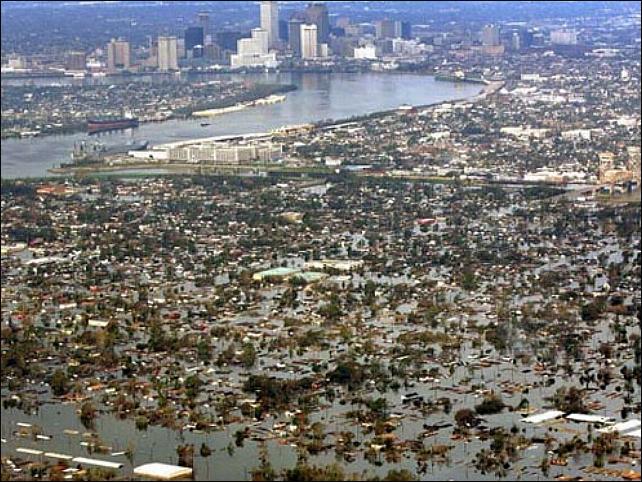
New Orleans following the 2005 hurricane.
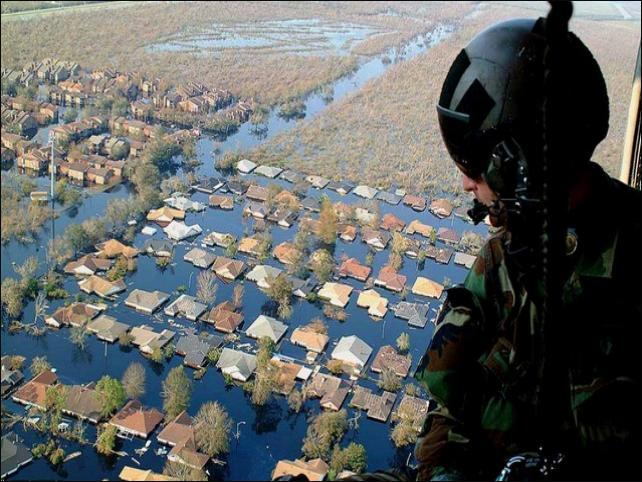
Searching for survivors
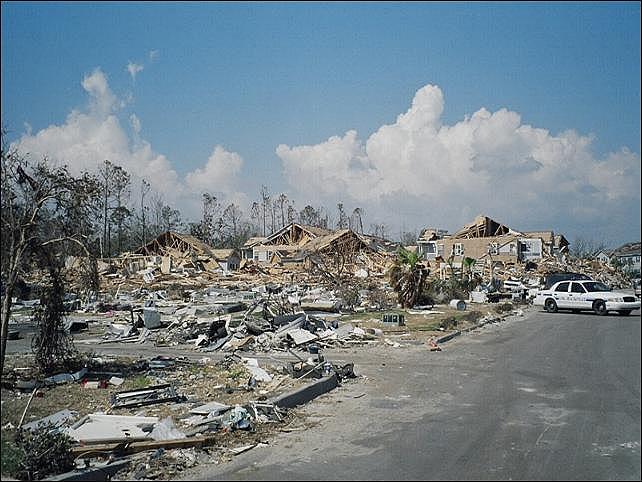
I remember watching the ominous
and dire predictions of a hurricane heading towards the
United States' southern coastline. It was named Katrina.
After it hit the coastlines of Louisiana and Mississippi
it was immediately clear that the devastation was beyond
comprehension. I was watching television newscasters
showed people scrambling to help others, and thinking
about how I'd always wanted to help with something like
this. Just then a notification came on the television
screen that if anyone wanted to volunteer, they should
contact their local Chapter of the American Red Cross.
So I contacted our local chapter that's been around for
about 100 years. They were setting up a training session
for volunteers at the fire department in a couple of
days, so I signed on over the phone.
During training we learned that
the American Red Cross is the first response to an
emergency in this country. This is a designation from
Congress. The Red Cross always teaches that everyone in
this country should be prepared in the event of an
emergency specific to their region, and be prepared to
survive on our own for three days. FEMA (The Federal
Emergency Management Agency) doesn't respond for 30
days, as their purpose is solely to engage in expected
"rebuilding" rather than responding to the initial
emergency. I was still training weeks before that time.
Red Cross's available volunteers increased from 20,000
to 200,000 in a few weeks. They had to immediately train
those who came forward, waive many normal requirements,
and get them out immediately. Many health conditions
normally prohibited were waived because of the
catastrophic need, but those with heart conditions were
advised not to participate with issues working in the
heat. Later, I noticed some unfortunately ignored the
warnings causing more problems for the Red Cross.
During the two day training
session there was a strong emphasis placed upon the need
for people who were flexible concerning last
minute changes of direction. At the conclusion of the
training, all were asked to sign on the dotted line only
if we were willing and able to be deployed within 24
hours. We were cautioned that no excuses would be
acceptable, and should be ready to move out within a few
minutes after notification by phone. The Red Cross
advised us to make our own flight, car rental, or other
necessary arrangements ourselves and deal with any
problems that might arise on the way. Our contact would
be waiting at the destination.
Within two days after completing
the training, I was called by Susan King of the Nevada
County Chapter and told I was being deployed to Baton
Rouge, Louisiana. I was given a number to call at the
local ARC Chapter, who provided the pertinent
information to make my own plane reservations. We
volunteers reported to the office and were given
personal Human Resources numbers and contact information
for our arrival at our various times and destinations. I
was being deployed for three weeks and given a stipend
of $500 strictly for reimbursement of enumerated items.
We were instructed to keep all of our receipts that
would be required to account for the money spent.
Cheryl and Glennie were driving me
to the Sacramento airport when I received a call that my
flight was delayed. Because I'd been given the
admonishment to get there immediately, I had to make
arrangements to fly out of Reno, where I spent the night
at niece Vicky's friend Guy's house. From there I used
my cell phone continually to make sure there weren't any
more hitches.
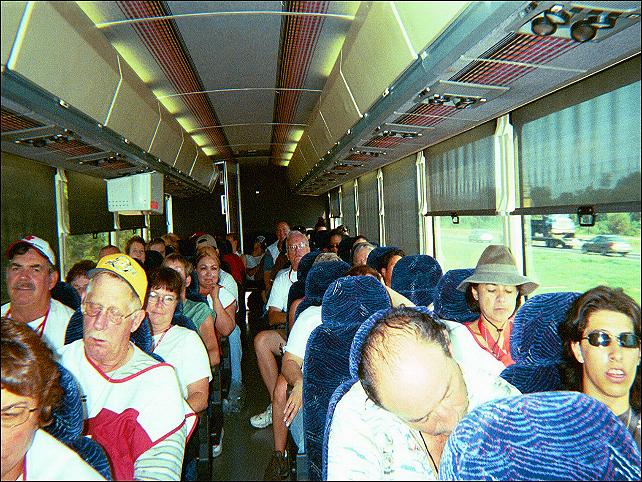
Riding the bus to Baton
Rouge
I arrived in Baton Rouge on
September 17, which is west of New Orleans. The
volunteers like myself who had arrived late in the
evening were taken to a school auditorium to spend the
night with hundreds of other volunteers who were already
sleeping on cots. In the morning we were transported by
bus to the ARC Central Command Center. There were
hundreds of people coming in and going out from various
stations throughout the large building. When we arrived
we were instructed to sign in and directed to move from
station to station learning what to do. We could then
sign up if we had specific training, skills, or desired
to work in certain areas. I felt kind of lost and
wondering what I could do. I was initially assigned to
Lake Charles, but that changed to a shelter in
Lafayette. While waiting instructions I met Jaret and a
great new friend who was deployed at the same time. Moe
Lopez was from Southern California. She talked about her
daughter who was breaking into the music industry as one
of "The Sol Luna Girls." Moe nicknamed herself
"Chunky Monkey," and I chose "Witto Susie" for myself.
We often laughed about writing a book called, "The
Adventures of Chunky Monkey & Witto Susie."
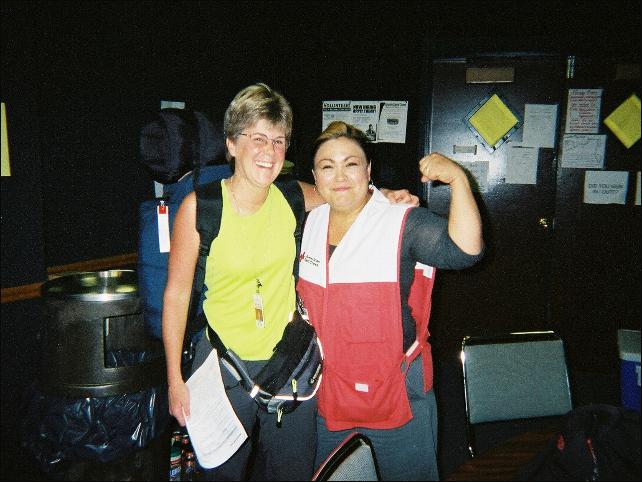
We began our service working at
the shelter in the Cajun Dome in Lafeyette, Louisiana
for a week. Moe was immediately assigned to be a night
manager as she had previously had experience at a
shelter in California. The population was initially
6,000 evacuees; however, when I arrived it had dwindled
to 3,000. The first morning I met with approximately 60
other volunteers. Various Department Managers provided
updates regarding preventing illnesses by encouraging
the use of gallon sized hand sanitizers throughout the
shelter. Within the week the evacuees dwindled to 2,000
as they made arrangements to move on with family,
relatives around the country. After the first week, we
were forced to evacuate the Cajun Dome, because
Hurricane Rita was now approaching. It was our job to
organize everyone for a bus trip north to Shreveport
before the storm hit.

Cajun Dome
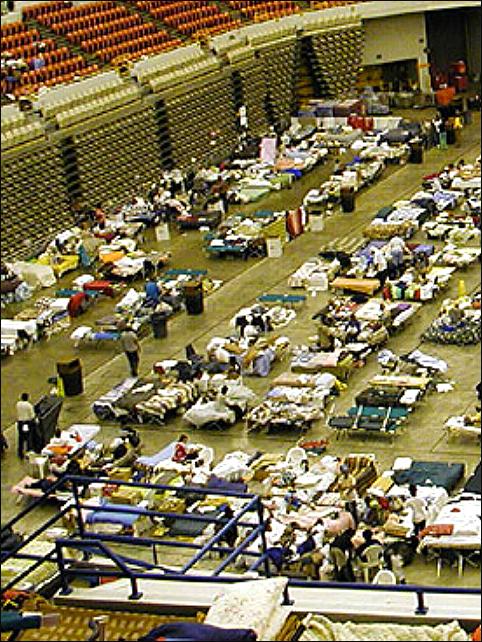
During our bus trip from
Lafayette, I rode for eight hours in the front seat
behind the driver who had been evacuating folks from the
beginning when Katrina hit. He told horrific stories.
What struck me most is that the Mayor of New Orleans
refused to allow the city transit buses to be used to
evacuate the residents who couldn't evacuate on their
own. He didn't want his buses ruined. The irony is that
they ended up under several feet of water and silt.
Instead of spending funds provided for better levees,
the mayor chose to spend the money on tourism. When
everything hit the fan he hightailed it and blamed
everything on President Bush.
We stayed in Shreveport a week,
where more evacuees arrived from the hard hit Lake
Charles area. The rain downpour was so extreme that
everyone stayed indoors. One problem was that some
evacuees were stockpiling, while others had nothing. I
started asking individuals regarding their needs and
instructed other ARC workers not to had them out in
lines that had formed. We went out on the floor to
determine needs, and personally obtain the items to fill
them. This worked well. It didn't take long to run short
on blankets because of the numbers of people arriving.
We couldn't locate any blankets in Louisiana or
Mississippi, so I sent people out to wash them at
a laundry mat, which was against the rules due to the
danger of disease, but we were desperate. One gracious
laundry donated two washers and dryers exclusively for
our use. These ran constantly through the night, but we
were still short on blankets. We newbees were beginning
to understand what it meant to be flexible. There was
some grumbling, but it was exciting and challenging to
just jump in and figure things out.
One guy I worked closely with was
somewhat of a rogue by failing to follow the rules. He
took off with vehicles rented by the Red Cross and ran
evacuees from one city or state to another. He later
told me that he went to New Orleans where he observed
the local police burglarizing the homes. They pointed an
AK-47 in his face saying, "Don't you know that marshal
law has been declared? If you move, you will be shot on
sight." He stayed put in the van afraid to move, until
the National Guard showed up later and asked what he was
doing. When he explained what had happened they
exclaimed, "marshal law has not been declared!" They
advised him to stay near them for the night. The next
morning they sent him on his way.
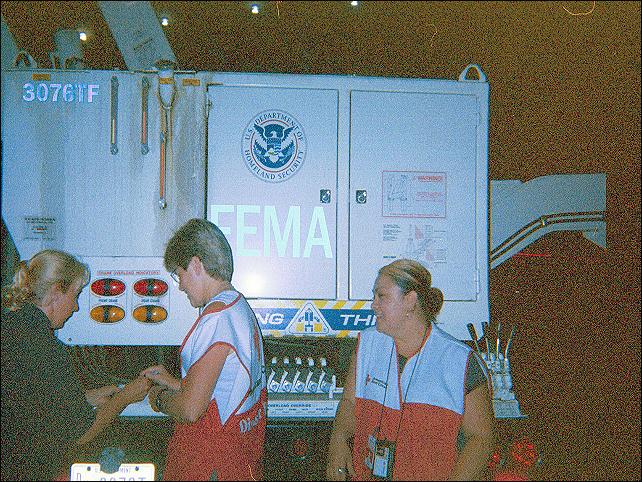
FEMA truck delivers blankets
Back in Shreveport a big truck
from FEMA showed up and I signed for 200 blankets. Yay!!
They had thousands, but I didn't want to hog them. I
also went to a local store and bought 50 with the money
the Red Cross had given me for my living expenses, which
I later had to report in writing and explain. The local
people in Lafayette were wonderful. I did see some
prejudice in Shreveport, much like between the north and
south. I don't understand that mentality. The white girl
born and raised in Nevada County was among a lot of
black folks. Some seemed to be intimidated, or felt
black people didn't like them. To that I responded,
"They're people. Just say hello first, smile and treat
them with respect like anyone else, and they'll respond
likewise." I didn't have any problem. There were creeps
running around and some arrests. Everyone was in the
same boat, whether a good citizen or a criminal. We
learned some young kids were molested in a bathroom and
there was some violence, but we had security consisting
of volunteers who were cops in their own cities.
Sometimes it was spooky walking through the dark halls
of the dome at night after lights out, but the National
Guard was there. When we got to Shreveport we had to
request security, that wasn't present....other than the
few we brought from the Red Cross. People knew how to
make things happen.
About a week in Shreveport and
after Rita finished it's fury, and the repairs to the
Cajun Dome were made, we returned "home" to the Cajun
Dome in Lafayette. I was appointed Logistics Manager for
the Dome. During one day of shopping I spent $8,000 for
food and other necessities. Two days before my departure
a couple of fellow Red Cross friends and I drove to New
Orleans on our day off. I have to say the worst hit was
St. Bernard Parrish (below).
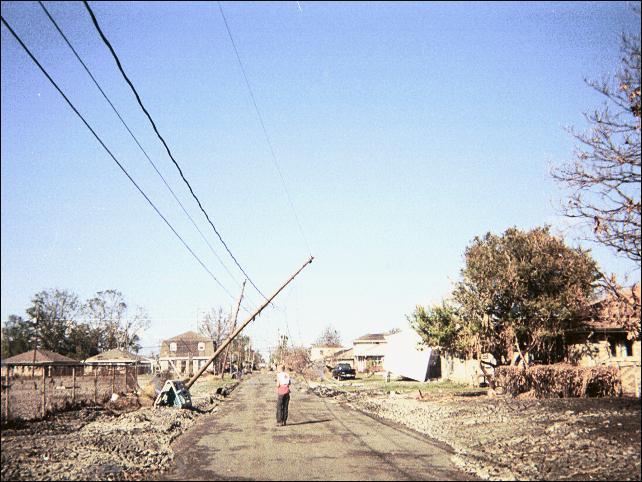
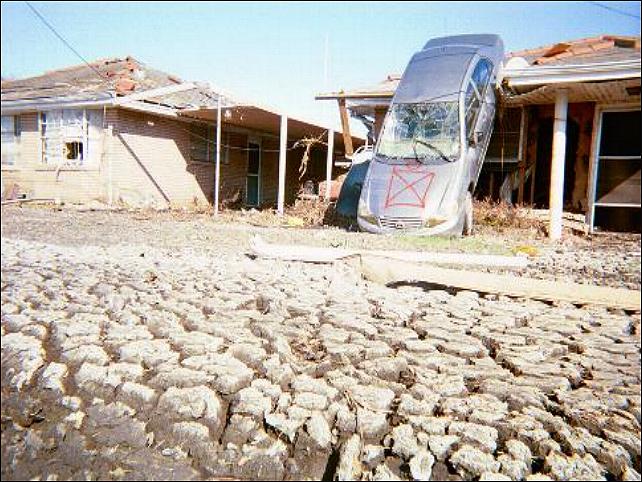
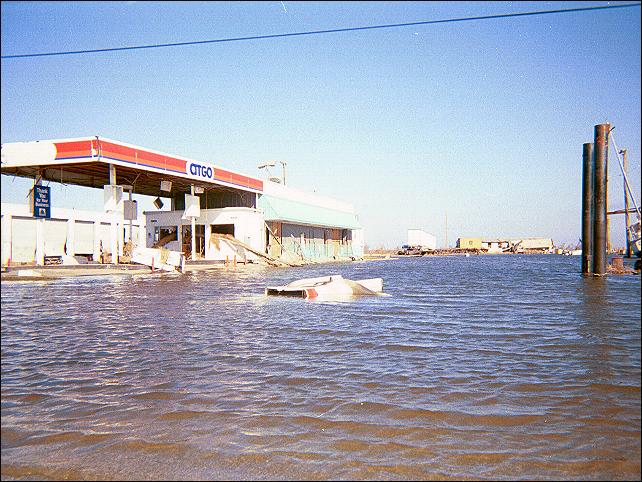
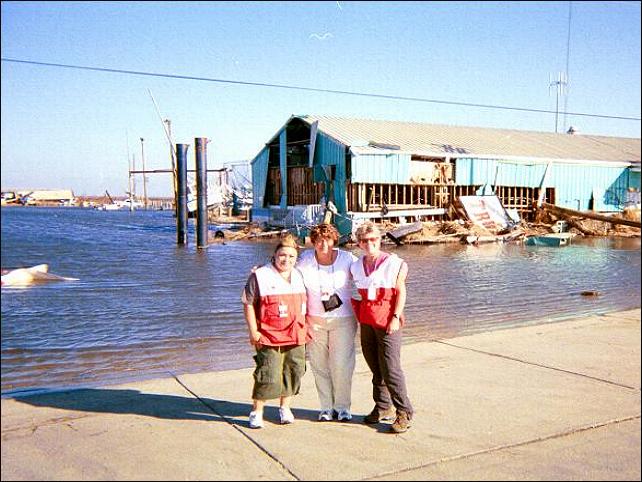
The new group replacing the
initial group with extensive experience and training
were literally newbees. It was something. By the time I
left, some of the initial ones came back as their
experience was needed for a second and third wave of
newbees.
When we talk about personal
responsibility we should all think about our own safety
in case of something catastrophic. Next it should fall
on city government, then county, then state, and finally
upon the federal government. I have little respect for
those in Louisiana's City of New Orleans and the State
government who accepted no responsibility and tried to
blame it on the furthest level of government...and the
President for their delinquency. And shame on those who
sat back and didn't volunteer, but were so quick to
point the blame finger at others. I hope I'll always
remember this when I'm not able or willing to personally
get in the trenches.
Not everything I saw was pleasant
from the perspective of volunteer help, but I was
totally impressed with the way the Red Cross and
National Guard handled problems. Swiftly and without
fanfare or disruption of business. We all learned a lot.
It was an amazing accomplishment during a natural
disaster. The earth could be destroyed in a day. We
can't prevent that. But for those who get off their
duffs, shut their mouths and get in the
trenches...hoorah!! And for those willing to open their
pocket books because they can't go, hoorah!! Those in
the media and idiots who use these disasters solely for
political gain might fool a lot of people, but God is
watching, and life is short.
Later...
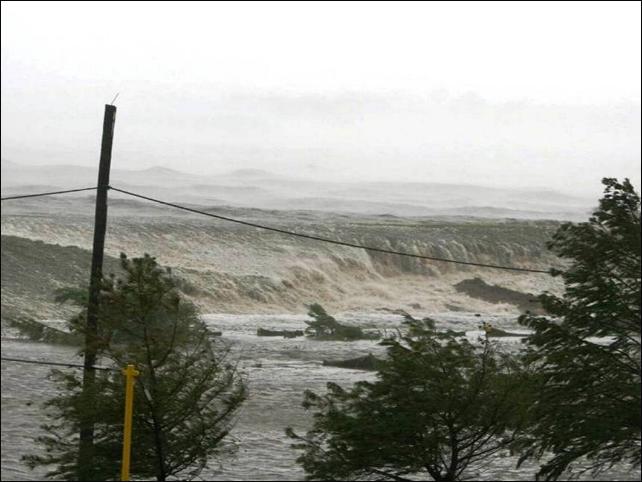
This photo was taken from the
third story balcony of Saint Stanislaus College located
next door to Our Lady of the Gulf Church in Bay Saint
Louis, Mississippi on the morning of August 29th. This
is believed to be the initial tidal wave from Hurricane
Katrina. It was approximately 35 to 40 feet high when it
slammed into the beach front communities of Bay Saint
Louis and Waveland. It completely destroyed 99 percent
of every structure along the beach for 9 miles and over
a mile inland. The flooding that continued inland
destroyed the contents of all but 35 homes in these two
communities of approximately 14,000 people.
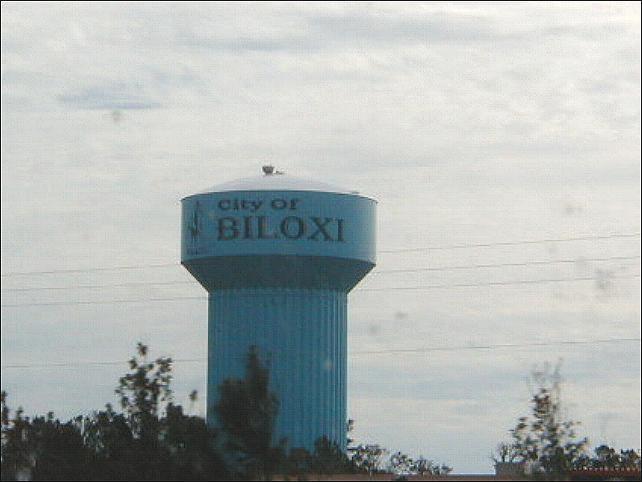
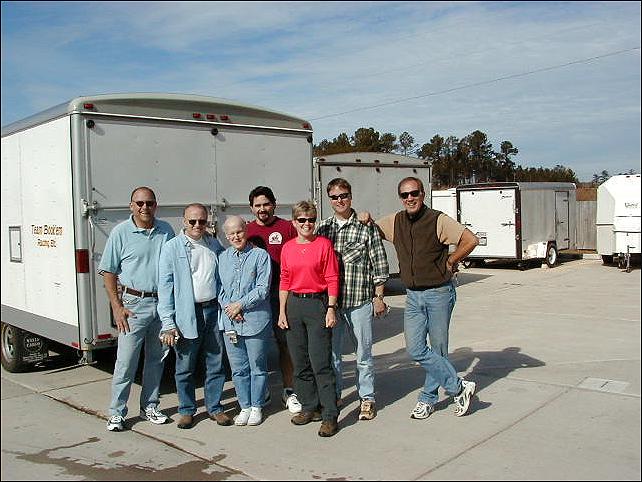
Just before Christmas a group of
us from Twin Cities Church drove to Biloxi, Mississippi
to deliver supplies and help a church we'd adopted. We
ended up working hard to get some folks back into their
home. I think Biloxi was much harder hit than New
Orleans. The devastation was unbelievable....like a war
zone. Every time we left the inside of the house we were
working on, it seemed like walking into a strange world
full of debris on land and in the remaining trees.
Devastated homes lifted from their foundations. Homes
where people died were marked. A storm came up during
our last day. The heavy rain was spooky. We were all in
our motor home, and just looked at each other like..."I
wanna go home." The pictures I took somewhat tell
the story, but the bigger picture is worse. We drove to
Gulfport and noted the total devastation. Homes turned
to rubble, and abandoned cars everywhere. Biloxi was a
nice and beautiful area before the hurricane. The water
raised 35 feet above sea level and the homes were 15
feet above.
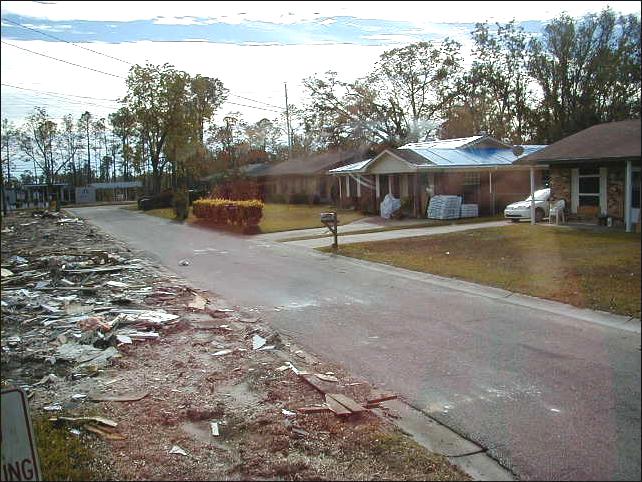
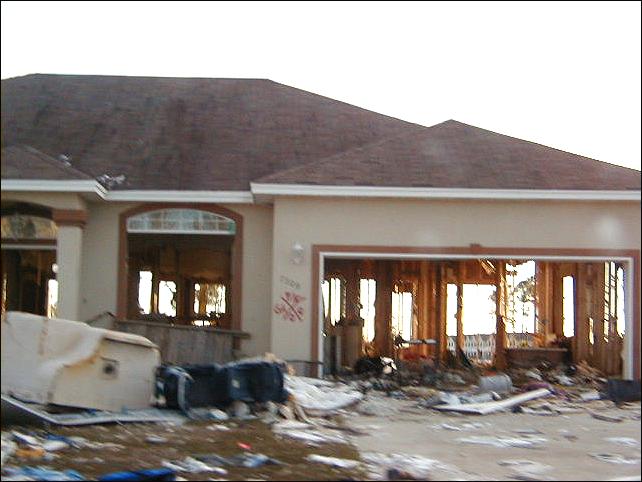
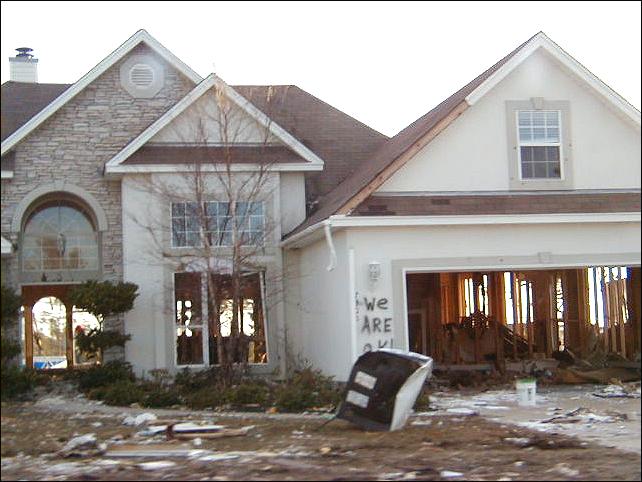
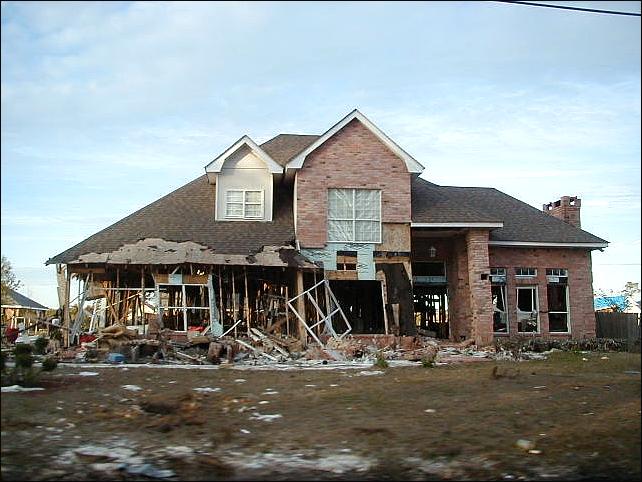
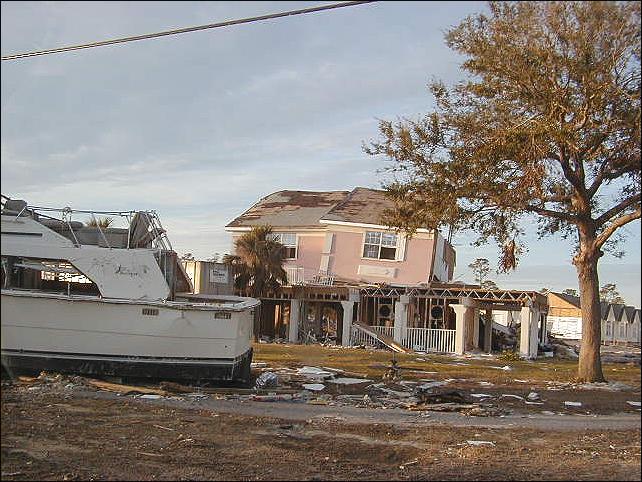
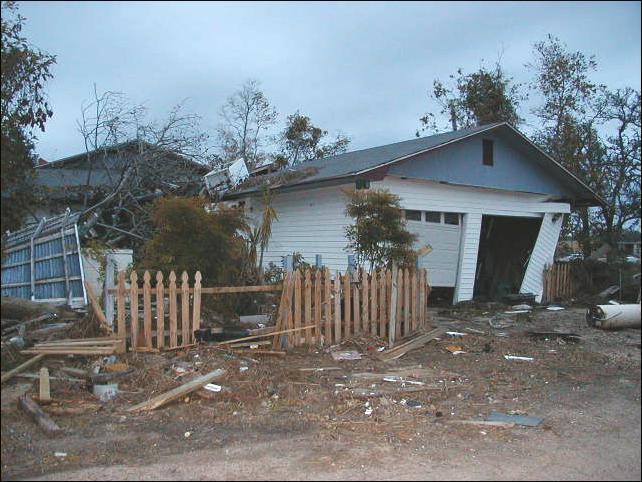
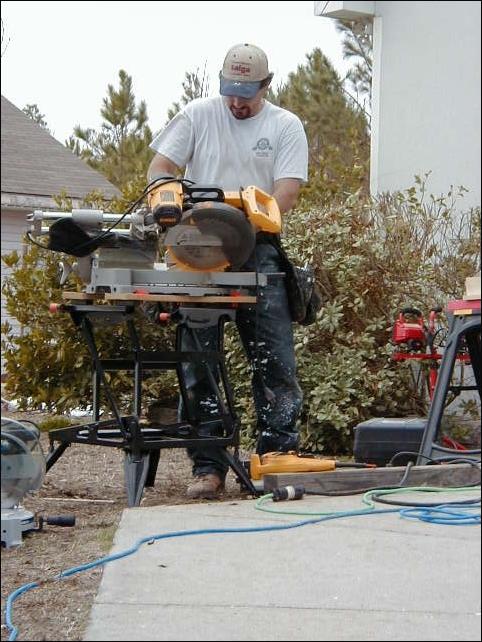
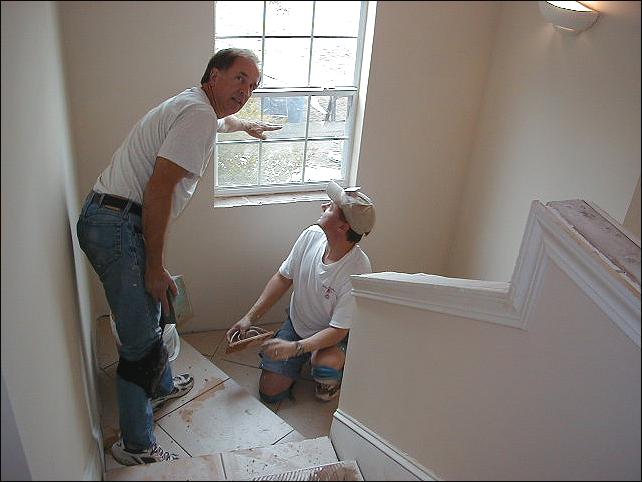
The second story of the
house we're working on. He's pointing to the water
mark
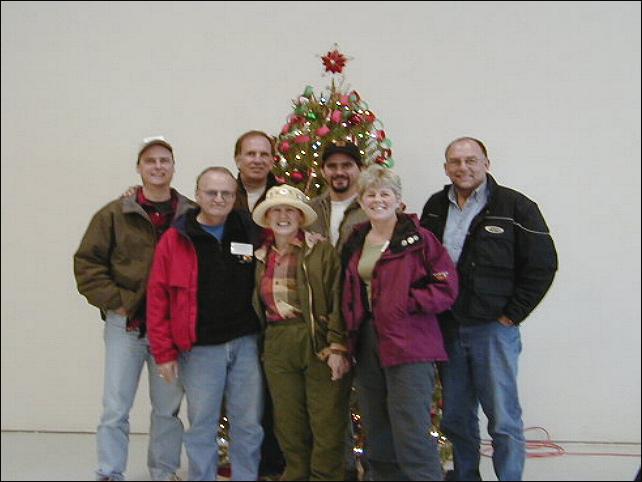
But it wasn't the famous sin city,
so they didn't get the attention. Nor was their State,
nor Mayor totally corrupt as in Louisiana. Having
received the training from the Red Cross, learning the
chain of command in an emergency, seeing what was going
on, and talking to people months after...my opinion is
that much of what the media fed us was nonsense. I
learned from folks in Biloxi the money from FEMA was
sent as were trailers, etc. However, distribution was
turned over to local contractors who failed to get them
distributed in a timely manner. While there, I saw
many trailers lined up and available for people to live,
but they were sitting on a lot, while many people were
living in tents and whatever shelter they could find.
Four years later, thousands of
displaced residents in Mississippi and Louisiana were
still living in trailers. Reconstruction of each section
of the southern portion of Louisiana has been addressed
in the Army Corps LACPR Final Technical Report which
identifies areas to not be rebuilt and areas buildings
need to be elevated.
Top
Back
|